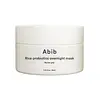What's inside
What's inside
 Key Ingredients
Key Ingredients

 Benefits
Benefits

 Concerns
Concerns

No concerns
 Ingredients Side-by-side
Ingredients Side-by-side

Water
Skin ConditioningCentella Asiatica Extract
CleansingGlycerin
Humectant1,2-Hexanediol
Skin ConditioningMethylpropanediol
SolventNiacinamide
SmoothingRosa Gallica Flower Powder
Skin ConditioningAcrylates/C10-30 Alkyl Acrylate Crosspolymer
Emulsion StabilisingXylitol
HumectantC12-14 Pareth-12
EmulsifyingTromethamine
BufferingCarbomer
Emulsion StabilisingSodium Hyaluronate
HumectantPanthenol
Skin ConditioningAdenosine
Skin ConditioningParfum
MaskingCamellia Sinensis Leaf Extract
AntimicrobialBrassica Oleracea Italica Extract
AstringentChamomilla Recutita Extract
Skin ConditioningHouttuynia Cordata Extract
Skin ConditioningAllantoin
Skin ConditioningDipotassium Glycyrrhizate
HumectantPolygonum Multiflorum Root Extract
Skin ConditioningPortulaca Oleracea Extract
Skin ConditioningPseudoalteromonas Ferment Extract
HumectantSaccharomyces Lysate Extract
HumectantMelia Azadirachta Leaf Extract
Skin ConditioningCitric Acid
BufferingMorus Bombycis Extract
AntimicrobialWithania Somnifera Root Extract
Skin ConditioningMelia Azadirachta Flower Extract
Skin ConditioningButylene Glycol
HumectantHydrolyzed Jojoba Esters
Skin ConditioningMadecassoside
AntioxidantAsiaticoside
AntioxidantHydroxypropyltrimonium Hyaluronate
Asiatic Acid
Skin ConditioningMadecassic Acid
Skin ConditioningHydrolyzed Hyaluronic Acid
HumectantSodium Acetylated Hyaluronate
HumectantHyaluronic Acid
HumectantHydrolyzed Sodium Hyaluronate
Skin ConditioningSodium Hyaluronate Crosspolymer
HumectantPotassium Hyaluronate
Skin ConditioningWater, Centella Asiatica Extract, Glycerin, 1,2-Hexanediol, Methylpropanediol, Niacinamide, Rosa Gallica Flower Powder, Acrylates/C10-30 Alkyl Acrylate Crosspolymer, Xylitol, C12-14 Pareth-12, Tromethamine, Carbomer, Sodium Hyaluronate, Panthenol, Adenosine, Parfum, Camellia Sinensis Leaf Extract, Brassica Oleracea Italica Extract, Chamomilla Recutita Extract, Houttuynia Cordata Extract, Allantoin, Dipotassium Glycyrrhizate, Polygonum Multiflorum Root Extract, Portulaca Oleracea Extract, Pseudoalteromonas Ferment Extract, Saccharomyces Lysate Extract, Melia Azadirachta Leaf Extract, Citric Acid, Morus Bombycis Extract, Withania Somnifera Root Extract, Melia Azadirachta Flower Extract, Butylene Glycol, Hydrolyzed Jojoba Esters, Madecassoside, Asiaticoside, Hydroxypropyltrimonium Hyaluronate, Asiatic Acid, Madecassic Acid, Hydrolyzed Hyaluronic Acid, Sodium Acetylated Hyaluronate, Hyaluronic Acid, Hydrolyzed Sodium Hyaluronate, Sodium Hyaluronate Crosspolymer, Potassium Hyaluronate
Water
Skin ConditioningDipropylene Glycol
HumectantGlycerin
HumectantGlyceryl Polymethacrylate
Lactobacillus/Rice Ferment
Skin Conditioning1,2-Hexanediol
Skin ConditioningDiglycerin
HumectantAmmonium Acryloyldimethyltaurate/Vp Copolymer
Oryza Sativa Bran Extract
Skin ConditioningAcrylates/C10-30 Alkyl Acrylate Crosspolymer
Emulsion StabilisingTromethamine
BufferingSaccharomyces/Rice Bran Ferment
HumectantEthylhexylglycerin
Skin ConditioningAdenosine
Skin ConditioningSodium Hyaluronate
HumectantAllantoin
Skin ConditioningDisodium EDTA
Water, Dipropylene Glycol, Glycerin, Glyceryl Polymethacrylate, Lactobacillus/Rice Ferment, 1,2-Hexanediol, Diglycerin, Ammonium Acryloyldimethyltaurate/Vp Copolymer, Oryza Sativa Bran Extract, Acrylates/C10-30 Alkyl Acrylate Crosspolymer, Tromethamine, Saccharomyces/Rice Bran Ferment, Ethylhexylglycerin, Adenosine, Sodium Hyaluronate, Allantoin, Disodium EDTA
 Reviews
Reviews

Ingredients Explained
These ingredients are found in both products.
Ingredients higher up in an ingredient list are typically present in a larger amount.
1,2-Hexanediol is a synthetic liquid and another multi-functional powerhouse.
It is a:
- Humectant, drawing moisture into the skin
- Emollient, helping to soften skin
- Solvent, dispersing and stabilizing formulas
- Preservative booster, enhancing the antimicrobial activity of other preservatives
Acrylates/C10-30 Alkyl Acrylate Crosspolymer is a synthetic polymer. It is used to thicken and improve the texture of products. Due to its properties, it can prevent water and oil ingredients from separating.
Adenosine is in every living organism. It is one of four components in nucleic acids that helps store our DNA.
Adenosine has many benefits when used. These benefits include hydrating the skin, smoothing skin, and reducing wrinkles. Once applied, adenosine increases collagen production. It also helps with improving firmness and tissue repair.
Studies have found adenosine may also help with wound healing.
In skincare products, Adenosine is usually derived from yeast.
Learn more about AdenosineAllantoin is a soothing ingredient known for its protective and moisturizingg properties. Because of this, it is often added to products with strong active ingredients.
Studies show higher concentrations of this ingredient can promote wound healing.
Though it can be derived from the comfrey plant, allantoin is produced synthetically for cosmetic products to ensure purity.
Learn more about AllantoinGlycerin is already naturally found in your skin. It helps moisturize and protect your skin.
A study from 2016 found glycerin to be more effective as a humectant than AHAs and hyaluronic acid.
As a humectant, it helps the skin stay hydrated by pulling moisture to your skin. The low molecular weight of glycerin allows it to pull moisture into the deeper layers of your skin.
Hydrated skin improves your skin barrier; Your skin barrier helps protect against irritants and bacteria.
Glycerin has also been found to have antimicrobial and antiviral properties. Due to these properties, glycerin is often used in wound and burn treatments.
In cosmetics, glycerin is usually derived from plants such as soybean or palm. However, it can also be sourced from animals, such as tallow or animal fat.
This ingredient is organic, colorless, odorless, and non-toxic.
Glycerin is the name for this ingredient in American English. British English uses Glycerol/Glycerine.
Learn more about GlycerinSodium Hyaluronate is hyaluronic acid's salt form. It is commonly derived from the sodium salt of hyaluronic acid.
Like hyaluronic acid, it is great at holding water and acts as a humectant. This makes it a great skin hydrating ingredient.
Sodium Hyaluronate is naturally occurring in our bodies and is mostly found in eye fluid and joints.
These are some other common types of Hyaluronic Acid:
Learn more about Sodium HyaluronateTromethamine helps balance the pH and improve the texture of a product. It is synthetically created.
As an emulsifier, Tromethamine prevents oil and water ingredients from separating. This helps stabilize the product and elongate a product's shelf life. Tromethamine also makes a product thicker.
Tromethamine helps balance the pH level of a product. Normal pH level of skin is slightly acidic (~4.75-5.5). The acidity of our skin is maintained by our glands and skin biome. Being slightly acidic allows our skin to create an "acid mantle". This acid mantle is a thin barrier that protects our skin from bacteria and contaminants.
Oral Tromethanmine is an anti-inflammatory drug but plays the role of masking, adding fragrance, and/or balancing pH in skincare.
1,3-Propanediol, 2-amino-2-(hydroxymethyl)-
Learn more about TromethamineWater. It's the most common cosmetic ingredient of all. You'll usually see it at the top of ingredient lists, meaning that it makes up the largest part of the product.
So why is it so popular? Water most often acts as a solvent - this means that it helps dissolve other ingredients into the formulation.
You'll also recognize water as that liquid we all need to stay alive. If you see this, drink a glass of water. Stay hydrated!
Learn more about Water